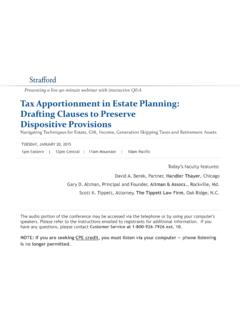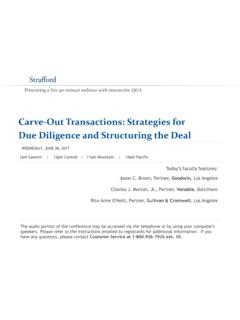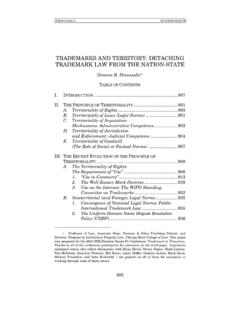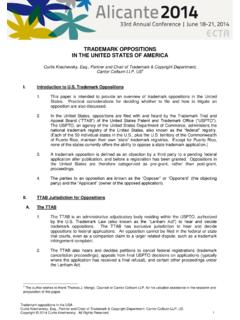Transcription of Protecting Trademark Rights Outside the U.S.
1 Protecting Trademark Rights Outside the Marks Abroad, Pros and Cons of the Madrid System, Enforcing IP RightsToday s faculty features:1pm Eastern | 12pm Central | 11am Mountain | 10am PacificThe audio portion of the conference may be accessed via the telephone or by using your computer's refer to the instructions emailed to registrants for additional information. If you have any questions, please contact Customer Service at 1-800-926-7926 ext. , JUNE 21, 2018 Presenting a live 90-minute webinar with interactive Q&AStephen Feingold, Partner, Kilpatrick Townsend & Stockton, New YorkBarbara J. Grahn, Partner, Fox Rothschild, MinneapolisRoberto Kunz-Hallstein, Partner, Dr. Kunz-Hallstein Rechtsanw lte, Munich, GermanyTips for Optimal QualitySound QualityIf you are listening via your computer speakers, please note that the quality of your sound will vary depending on the speed and quality of your internet the sound quality is not satisfactory, you may listen via the phone: dial 1-866-570-7602and enter your PIN when prompted.
2 Otherwise, please send us a chator e-mail so we can address the you dialed in and have any difficulties during the call, press *0 for QualityTo maximize your screen, press the F11 key on your keyboard. To exit full screen, press the F11 key LIVE EVENT ONLYC ontinuing Education CreditsIn order for us to process your continuing education credit, you must confirm your participation in this webinar by completing and submitting the Attendance Affirmation/Evaluation after the webinar. A link to the Attendance Affirmation/Evaluation will be in the thank you email that you will receive immediately following the additional information about continuing education, call us at 1-800-926-7926 ext. LIVE EVENT ONLYP rogram MaterialsIf you have not printed the conference materials for this program, please complete the following steps: Click on the ^ symbol next to Conference Materials in the middle of the left-hand column on your screen.
3 Click on the tab labeled Handouts that appears, and there you will see a PDF of the slides for today's program. Double click on the PDF and a separate page will open. Print the slides by clicking on the printer LIVE EVENT ONLYINTERNATIONAL PROTECTION OF TRADEMARKSB arbara J. Protection of Trademarks Some preliminary considerations: First to Use or First to File Common law countries generally recognize TM Rights based on use and the first to use the mark has priority U. S., UK, Canada, Australia, New Zealand Most countries recognize Rights based on registration and the first to file has priority. Must register the mark in most countries to have Rights unless the mark is famous or, in some cases, has developed a reputation6 International Protection of Trademarks Some marks registrable in the U.
4 S. may not be registrable or enforceable abroad: Colors Sounds Product configurations Two-letter marks Geographic terms Combinations of numbers Slogans7 International Protection of Trademarks Registering translations or transliterations of marks, , Katakana in Japan U. S. doctrine of foreign equivalents is not followed in most other countries But, if the mark won t be used in the foreign language or characters, the registration may ultimately be vulnerable to cancellation and unenforceable8 International Protection of Trademarks Most countries do not require proof of use to obtain registration Use is required to maintain Rights in the registration in most countries If the mark is not used within a set period at any time after registration (almost always 3 or 5 years, depending on the country)
5 , the registration can be cancelled for non-use by a third party A third party can require proof of use in an infringement action or an opposition 9 International Protection of Trademarks Which marks to file House marks used across the applicant s full range of products and services Is it a core product or secondary product? If the mark is used in all or most key markets Sub-brands, regional brands, limited range of products or services Slogans, non-traditional marks such as product configurations, color, trade dress may not be registrable in many other countries 10 International Protection of Trademarks Other considerations Will the duration of use be limited (as, for example, an advertising slogan or another temporary use)?
6 What is the expected life cycle of the product? What resources will be devoted to promoting the mark? How strong is the mark? Will it be widely registrable?11 International Protection of Trademarks Where to register File first in Countries where the mark is in use or will be used soon Countries where the mark will be used within the next few years Countries where defensive filings are advisable Consider effect of failure to use. Can refile if necessary to avoid non-use vulnerability12 International Protection of Trademarks Benefits of Paris Convention Priority Applications filed in other member countries for the same goods/services within six months of a U. S. application will have the benefit of the U. S. filing date for priority purposes Allows time to see if U.
7 S. application will be accepted Allows owner to spread out or delay costs of foreign filing May allow time to judge whether the product will be successful Can only claim priority from the first application filed in a member country13 International Protection of Trademarks International Clearance Almost any combination of searches available through search firms worldwide, regional, country-specific SAEGIS now covers 185+ countries, the EU all International Registrations, and 20 domain name databases economical for preliminary screening purposes TMView on EUIPO website -covers approximately 60 databases Many countries make their databases available for searching in English Searches and opinions by local counsel14 International Protection of Trademarks Cautions.
8 Trademark registers not always accurate or searchable Delay between filings and appearance in the register may be significant May not be possible to search in local alphabets, non-Roman characters Practices vary widely regarding descriptiveness, confusing similarity, relatedness of goods So obtain search and opinion from local counsel for important countries Depending on timing of introduction of product or service, may simply file and deal with refusals or oppositions at that time15 International Protection of Trademarks Dealing with refusals Lack of distinctiveness May be able to overcome with showing that mark as been registered in other jurisdictions May be able to demonstrate acquired distinctiveness Likelihood of confusion Only in countries that examine on relative grounds not all jurisdictions do May be able to overcome with a showing that mark is famous or has developed a reputation in the country prior to the filing of the conflicting application or registration16 International Protection of Trademarks Dealing With Refusals Consents or prior Rights agreements are commonly used Not all countries accept
9 Consents, or will require additional evidence of co-existence without confusion May have to temporarily assign application to owner of prior cited registration, who agrees to assign the registration back to the owner when it issues17 International Protection of Trademarks Multi-national registration regimes EUIPO(Europe) OAPI (French-speaking Africa) ARIPO (English-speaking Africa) Andean Pact (not really a multi-country registration, but provides some reciprocal Rights for marks registered in other member countries) Madrid Protocol International Registration18 Protecting Trademark Rights Outside the the Madrid SystemRoberto Kunz-HallsteinDr. Kunz-Hallstein Rechtsanw lteGaleriestrasse 6a80539 Kunz-Hallstein Advantages of using Madrid Costs:One application may cover up to 101 countries / regionsPossibility for fall back positions: (EUTM/UK Brexit)A: Some countries require second payment of official fees, especially Japan.
10 Fees must be paid with WIPO Easy Handling:-Limitations, Restrictions, Assignments, Renewals may be filed with one Office-All forms are available online at: :special requirements for maintenance in the US, Philippines, Mexico(?)20Dr. Kunz-Hallstein Advantages of using Madrid Multi-class registrations in countries which normally allow single class applicationsonly Subsequent designationsA:Estonia, Namibia, India, Philippines and Turkey: no subsequent designations for international registrations which were registered prior to the accession of the designated country Recordal of Licenses with WIPOA:The recordal with WIPO is not effective in some jurisdictions, especially China, India, Japan, Mexico, Republic of Korea, Russian Federation, Singapore (and others)21Dr.



















